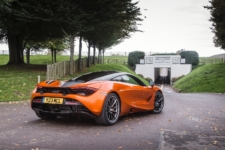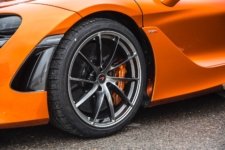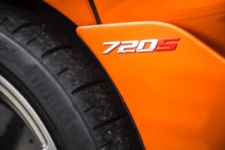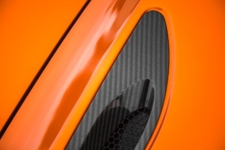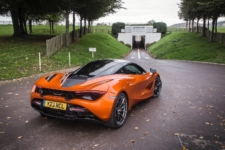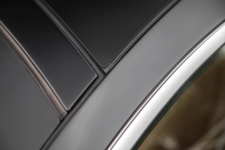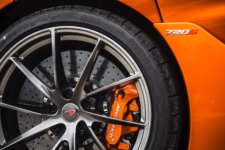Where do you begin when you have stepped out of one of the world’s most fantastic cars?
Tom Scanlan goes ballistic in the McLaren 720S Performance
Fantastic is a good word, but it isn’t enough just to call the McLaren 720S fantastic. You have to add in ‘brilliant,’ ‘superb,’ ‘stupendous’, and a few more…
The 720S represents the first time that McLaren has replaced a model family. By that, their Super Series, the core of their car business, they mean that the McLaren 650S is defunct (read our review) and we hail the new king, the McLaren 720S Performance. (McLaren’s other ‘families’ are the entry-level Sport Series and the self-explanatory Ultimate Series.)
The 720S has a larger engine, up from 3.8 litres and 650 PS to 4 litres and 720 PS (710 bhp), the engine still being a twin turbo V8. This extraordinary powerhouse now has lighter pistons and con rods and a stiffer and lighter crankshaft. The turbochargers and intercoolers are entirely new, with lightweight turbines.
Throttle response has been calibrated, whether on or off, to give the best blend of immediate reaction and progressive control. And the torque figure of 770 lb/ft is nothing to be sniffed at.

The car features the new generation of McLaren’s Proactive Chassis Control, with the new suspension.
Its lightweight, based on its carbon fibre chassis, beats such fine performers as the Porsche 911 Turbo S by 166 kg, the Lamborghini Huracan by 183 kg and the Audi R8 V10 Plus by a whopping 228 kilograms. That’s significant.
All that translates into the most extraordinary acceleration from a standstill that I have ever experienced: the country road was empty; it was also rather near narrow and lined with hedgerows, it had a poor surface and had a series of several ups and downs over a short distance.
I had the car in automatic mode and just floored it. It’s hyperbolic to say that I felt like someone had lobbed a stun grenade into the car.
McLaren’s numbers say the car hits 60mph in a ridiculously-fast 2.8 seconds, but the point is that the experience was sudden and shattering. Oh yes, and nought to 124 mph takes a mere 7.8 seconds and compared to the 650S’ 8.4 seconds (no chance of testing these stats out!). Top speed, they say, is 212 mph. The red line is at just over 8000 rpm, not that I had time to notice.
On reflection later, what was so deeply impressive was the way that the car had glued itself to that awful surface. Just a couple of little nano-squeals retained in my slowly-evolving memory of those short moments, along with the mad exhaust howl..and the brakes — a sort of reverse, eye-bulging, experience that underlined how hugely capable this car is.
Taking bends at speed was another joyous experience, and the sense of safety and security all the while never diminished.
For more sheer fun, switch the car to Manual and use the paddles…click – instant change, click – instant change, click – instant change…you get the picture. You have to get your money’s worth any way you can and that’s just one of them.
But the car is very much not just about driving like a wanna-be Formula 1 racer. Normal traffic conditions kept the drive to, well, normal. The 720S is very easy to potter about in, to crawl in traffic jams, to sit at 30 mph if that’s what the road sign says. The steering is nicely-weighted and of course accurate.
The interior is truly quite spacious, although access is ever so slightly contortedly because of the upwards-opening doors. The soft-leather seats beautifully designed, the head-room impressive and a light and airy feeling thanks particularly to the roof’s pair of windows, one above each seat. The finish as expected is impeccable.
The car, with its doors opening upwards, is, as I say, not so difficult to get into and out of. Once aboard, the seats have adjustments that will enable pretty well any driver to find the optimum driving position, except perhaps Lurch from The Addams Family.
The nicely-crafted aluminium circular switch-buttons are where you go to for the main driving configurations and are neatly laid out so that it’s simple to get from comfort to sport to track depending on how you would like the car to feel and respond at any given time. In the Track setting, the instrument panel swops itself for a smaller version for better visibility, a very neat feature. The low nose can be raised, as before, if necessary, to cope with angles entering driveways, driving on and off ferries and the like.
The 720S is breathtakingly beautiful from any angle, surely not just in my eyes, and, with the lights on at dusk, even more so.
The car driven was the Luxury version, starting at £218,020.
You can spend a lot more on options; for example, the lightweight wheels with Titanium Liquid Metal Finish (£1550) added £4630 to the total. The weight-saving was about 4.6 lbs per wheel, working out at £665 per wheel, or roughly £150 per pound weight!
McLaren would hope that this remarkable performer that can be fast and furious will be bought not just as a street fighter, but as a genuine all-rounder able to be used as an everyday super-car.
Unless it’s bought as an investment, that is certainly what should be the case. As it happens, just to take one example, a short-time pre-owned McLaren 720S has been advertised at £285K…a serious investment, therefore.
Fuel consumption? Driven hard wherever possible, the test route of eighty miles gulped petrol to the extent of a gallon every 13.4 miles. With the 72-litre tank, that’s a range of not much more than two hundred miles. But I guess that owners would ordinarily get up around twenty mpg making it well over three hundred between fill-ups, not including track days, though. The official combined figure is 26.4 mpg.
How to sum up the 720S? ‘Wow,’ just ain’t good enough.
Car reviewed: McLaren 720S Performance – Base Price On the road £218,020 Options added a further £30,810 to car tested 0-60mph 2.8 secs Top speed 212mph Fuel Economy combined 26.4mpg CO2 emissions 249g/km Engine 4.0-litre twin -turbo V8 3,994cc Max Power 710HP@5500 rpm Torque 770Nm@5500rpm Transmission Seven-Speed Seamless Shift Gearbox (SSG)
Ballistic performance
A technological Tour de force
Spacious and stylish interior
Just can't afford one
No items found, please search again.



